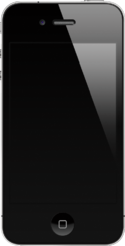IPhone 4

iPhone 4 in Black
|
|
| Developer | Apple Inc. |
|---|---|
| Manufacturer |
Foxconn (UMTS/GSM model) Pegatron (CDMA model) |
| Slogan | "This changes everything. Again." |
| Generation | 4th |
| Model | A1332 (GSM model) A1349 (CDMA model) |
| First released |
GSM model (black): June 24, 2010 CDMA model (black): February 10, 2011 GSM and CDMA models (white): April 28, 2011 |
| Discontinued | September 10, 2013 |
| Predecessor | iPhone 3GS |
| Successor | iPhone 4S |
| Related | iPad, iPod Touch (comparison) |
| Type | Smartphone |
| Form factor | Slate |
| Dimensions | 115.2 mm (4.54 in) H 58.6 mm (2.31 in) W 9.3 mm (0.37 in) D |
| Weight | 137 g (4.8 oz) |
| Operating system |
Original: iOS 4.0 (GSM model), iOS 4.2.5 (CDMA model) Current: iOS 7.1.2, released June 30, 2014 |
| System on chip | Apple A4 |
| CPU | 1 GHz (Underclocked to 800 MHz) single core 32-bit ARM Cortex-A8 "Hummingbird" |
| GPU | PowerVR SGX535 |
| Memory | 512 MB DRAM |
| Storage | 8, 16, or 32 GB flash memory |
| Battery | 3.7 V, 5.3 Wh (1,420 mAh) Lithium-ion battery |
| Data inputs |
Multi-touch touchscreen display Dual microphone 3-axis gyroscope 3-axis accelerometer Digital compass Proximity sensor Ambient light sensor |
| Display | 3.5 in (89 mm) diagonal 1.5:1 aspect ratio widescreen LED backlit IPS TFT LCD 960×640 resolution at 326 ppi (0.61 megapixels) 800:1 contrast ratio (typical) 500 cd/m2 max brightness (typical) Fingerprint-resistant oleophobic coating on front and back glass |
| Rear camera | 5 MP back-side illuminated sensor HD video (720p) at 30 frame/s 1.75 μm size pixels 5× digital zoom 4 element lens LED flash Photo and video geotagging |
| Front camera | 0.3 MP VGA (480p) at 30 frame/s 25 μm size pixels Tap to focus video or still images Photo and video geotagging |
| Sound | Single loudspeaker 3.5 mm TRRS, frequency response: 20 Hz to 20 kHz |
| Connectivity |
Wi-Fi (802.11 b/g/n) (2.4 GHz only) |
| Development status | Discontinued |
| Hearing aid compatibility |
GSM 3G 850/1,900 MHz M4, T4 2G 850 MHz M3, T3 2G 1,900 MHz M2, T3 CDMA M4, T4 |
| Website | Official website |
Wi-Fi (802.11 b/g/n) (2.4 GHz only)
Bluetooth 2.1 + EDR
GSM model: quad-band GSM/GPRS/EDGE
(800, 850, 900, 1,800, 1,900 MHz)
Quad-band UMTS/HSDPA/HSUPA
(800, 850, 900, 1,900, 2,100 MHz) (800 MHz is not yet officially supported by Apple)
The iPhone 4 is a smartphone that was designed and marketed by Apple Inc. Following a number of notable leaks, the iPhone 4 was first unveiled on June 7, 2010, at Apple's Worldwide Developers Conference in San Francisco, and was released on June 24, 2010, in the United States, United Kingdom, France, Germany and Japan. It is the 4th generation of iPhone, succeeding the 3GS and preceding the 4S.
The iPhone 4 introduced a new hardware design to the iPhone family, which Apple's CEO Steve Jobs touted as the thinnest smartphone in the world at the time; it consisted of an uninsulated stainless steel frame which doubles as an antenna, with internal components situated between chemically strengthened aluminosilicate glass. The iPhone 4 also introduced Apple's new high-resolution "Retina Display"; while maintaining the same physical size and aspect ratio as its precursors, its liquid crystal display had a pixel density of 326 pixels per inch. The iPhone 4 also introduced Apple's A4 system-on-chip, along with iOS 4—which notably introduced multitasking functionality and Apple's new FaceTime video chat service. The iPhone 4 was also the first iPhone to include a front-facing camera, and the first to be released in a version for CDMA networks, ending AT&T's period as the exclusive carrier of iPhone products in the United States.
...
Wikipedia
